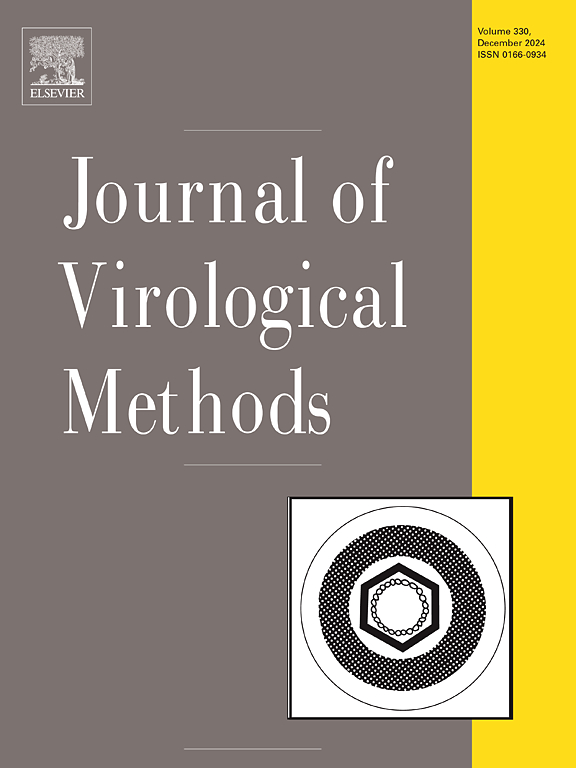比较检测HIV-1病毒粒子表面细胞蛋白的方法。
IF 1.6
4区 医学
Q3 BIOCHEMICAL RESEARCH METHODS
引用次数: 0
摘要
HIV-1的表面嵌入了许多宿主来源的蛋白质。表征这些蛋白质可以增强对病毒生物学的认识,并有可能确定新的治疗靶点。由于许多这些蛋白质在病毒粒子表面的丰度很低,它们的鉴定可能会受到检测它们的方法中的固有变量的阻碍,包括它们不同的测定灵敏度、样品处理、定量能力和实验可重复性。在这里,我们比较了传统的病毒免疫捕获法和western blotting法以及一种称为流动病毒学(FV)的新兴技术对病毒粒子结合蛋白的定量分析。使用四种不同的假病毒模型,每种都表达一种感兴趣的人类蛋白质(CD14, CD38, CD59和CD162),我们比较了四种实验技术可靠地量化这四种蛋白质在病毒粒子表面结合的能力。我们的结果揭示了检测病毒粒子结合蛋白的每种技术的优点和注意事项,并突出了每种技术在不同实验条件下的量化广度。用流动病毒法检测蛋白质具有明显的优势,因为它具有高度可重复性的定量,具有最低的样品要求和试剂成本,以及最少的动手实验时间。在研究病毒粒子结合蛋白时,我们还强调了实验设计中的一些重要考虑因素,如不同抗体克隆的影响、实验孵育时间和细胞外囊泡的贡献。最重要的是,我们的数据说明了使用正交方法组合检测病毒相关蛋白的重要性,以实现可靠和可重复的量化,以解释个体分析偏差。本文章由计算机程序翻译,如有差异,请以英文原文为准。
Comparing methods to detect cellular proteins on the surface of HIV-1 virions
The surface of HIV-1 is embedded with numerous host-derived proteins. Characterizing these proteins can enhance knowledge of virus biology and potentially identify novel therapeutic targets. As many of these proteins are present in low abundance on virion surfaces, their identification can be hindered by inherent variables in the methods employed to detect them, including their varying assay sensitivities, sample processing, quantitative capacity, and experimental reproducibility. Here, we have compared the quantification of virion-incorporated proteins using conventional virus immunocapture assays and western blotting, alongside an emerging technique called flow virometry (FV). Using four different pseudovirus models that each express a human protein of interest (CD14, CD38, CD59 and CD162), we compared four experimental techniques for their ability to reliably quantify the incorporation of those four proteins onto virion surfaces. Our results shed light on the advantages and caveats of each technique for detecting virion-incorporated proteins and highlight the breadth in quantification for each technique under different experimental conditions. Protein detection with (FV) provided distinct advantages as it enabled highly reproducible quantifications, had the lowest sample requirements and reagent costs, and minimal hands-on experimental time. We additionally highlight some important considerations in experimental design when studying virion-incorporated proteins, such as the effect of different antibody clones, assay incubation times, and contributions of extracellular vesicles. Most importantly, our data illustrate the importance of using a combination of orthogonal approaches to detect virus-associated proteins, to enable reliable and reproducible quantification that accounts for individual assay biases.
求助全文
通过发布文献求助,成功后即可免费获取论文全文。
去求助
来源期刊
CiteScore
5.80
自引率
0.00%
发文量
209
审稿时长
41 days
期刊介绍:
The Journal of Virological Methods focuses on original, high quality research papers that describe novel and comprehensively tested methods which enhance human, animal, plant, bacterial or environmental virology and prions research and discovery.
The methods may include, but not limited to, the study of:
Viral components and morphology-
Virus isolation, propagation and development of viral vectors-
Viral pathogenesis, oncogenesis, vaccines and antivirals-
Virus replication, host-pathogen interactions and responses-
Virus transmission, prevention, control and treatment-
Viral metagenomics and virome-
Virus ecology, adaption and evolution-
Applied virology such as nanotechnology-
Viral diagnosis with novelty and comprehensive evaluation.
We seek articles, systematic reviews, meta-analyses and laboratory protocols that include comprehensive technical details with statistical confirmations that provide validations against current best practice, international standards or quality assurance programs and which advance knowledge in virology leading to improved medical, veterinary or agricultural practices and management.

 求助内容:
求助内容: 应助结果提醒方式:
应助结果提醒方式:


